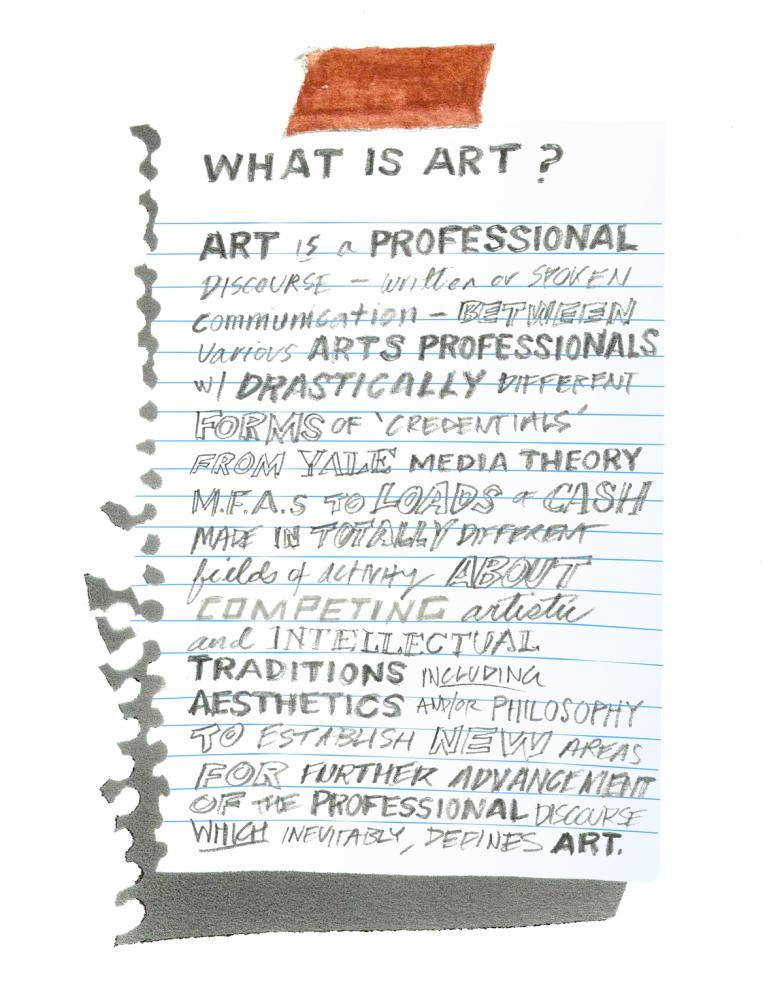New Print Edition Available I made this series of unique multiples last fall for Art for Artists editions, an art trade project organized by the artist duo Ghost of a Dream. When I scanned the drawings the blue line work and shadows on the paper were blown out by the cheap affordable Kinko’s machine, so I’ve created a digital version of the works that I am currently printing as a suite of 12 archival inkjet prints. The edition will be available later this summer, but these images are freely available fore reflection on the question, “What is Art?” Update: The suite of prints of the series, What is Art? is now available through Platform Gallery. The suite includes the entire series of 12 11" x 14" archival inkjet prints on Duo Matte 80 bright white paper in an archival folio for $800 plus $25 for flat rate shipping in the US. All of the prints are numbered with the suite edition number, signed, and dated. The edition size is limited to 20 and two artist proofs.
[caption id=“attachment_4631” align=“alignnone” width=“940”]
Installation shot ‘New York Times Review (After Büchel)[/caption]
I’ve contributed a ‘translation’ of Roberta Smith’s 2007 review of Christoph Büchel’s tarped over show at Mass MoCA to the Flag Art Foundation’s summer group show, ‘The Times’. I’ve modified her original review to address some of the issues present in my exhibition ‘After The Contemporary’ at the Aldrich in Connecticut_, _but primarily to replace a 2007 work _New York Times Review (Almost) _that has disappeared. The work has gone missing and I’m not quite sure what happened to the drawing, so I’ve replaced it. I was also thinking about the diminishing presence, both physical and intellectually of the Times, and perhaps the loss of credibility following its horrible election coverage and recent editorial hires. The decision to propose my own review isn’t wholly solipsistic and self-referential, but a reminder that The NY Times cut all of its regional arts coverage, which only serves to further New York’s bubble of self-importance. An arts journalist pointed out to me that the new drawing, N_ew York Times Review (After Büchel), _is the only visual art work in the show that represents the digital version of the times (although I learned another artist, Jason Bailer Losh from Los Angeles, has created a series of podcasts inspired by the Times for the show). I found it amusing that I was the only artist to visually reference the way many of us, who still subscribe, end up reading the Times, on screens.
For a sense of the installation of my current show, After the Contemporary, at the Aldrich, you can take a low-tech virtual tour of the show (which I’ve made using a thing called strut.io, a GUI for editing a javascript called Impress). After the Contemporary is set in the year 2050 and is a retrospective look at twenty-five years of market-driven art exemplified by the ascendence of the art fair booth and the supremacy of formalism over content during a period of extreme wealth and income inequality. I’ve made this because I hope it will encourage you to take the train or a leisurely drive up to Ridgefield, Connecticut which is about an hour and half outside of New York City and visit my show along with three other concurrent solo exhibitions by Beth Campbell, Kay Rosen, and Suzane McClelland. The shows are all up through September 4th offering an ideal excuse to flee the summer hellscape of New York City. Eventually, I will give in and make a legible version of the show available online, but you can’t separate the content from the museum for what makes this an exhibition, rather than a collection of objects for sale, like the Grevsky’s featured in the show (which are available for sale at www.grevsky.com)* [caption id=“attachment_4620” align=“alignnone” width=“940”]
After the Contemporary, virtual walkthrough screen shot [/caption] *Time is a relative concept within the ‘conceptual framework’ of the exhibition.
After The Contemporary opens Sunday March 5th from 2 - 5 pm at the Aldrich Contemporary Art Museum in Ridgefield, CT. Holland Cotter offers a quick take in the New York Times and you can read the museum press release here. Grevsky, a bespoke contemporary art service, will be presenting its 2019 Winter Collection, the PDF catalog is now available on the company’s website. The Stolbun Collection at the Aldrich has generously re-produced its 2019 New York art fair week booth for the exhibition, which offers a a review of the Contemporary from the year 2050. Time is _conceptual _and subject to interpretation. [caption id="" align=“alignnone” width=“1945”] Grevsky, 2019[/caption]
“Powhida’s scathing, hyperbolic analysis is clear, clean, and powerful, not to mention masterfully drawn and designed (the facial expressions, especially the creepily self-satisfied smiles on the faces of Trump, Shkreli, Duke, and Hitler, are highly effective; so are such grace notes as the reflected light in the shadow engulfing half of Michael Myers’s face). The drawing’s formal sophistication coupled with its levels of meaning and layers of context remove it entirely from the realm of political cartooning, but where does it land? And how will we address it once the threat of a Trump presidency (presumably November 9th) is over?” -Thomas Michelli, Hyperallergic, The Shelf Life of Political Art




















